Acer R7 Review: Something Different
by Jarred Walton on August 15, 2013 12:45 AM ESTI’m going to stuff all of the benchmarks onto one page for this review; there’s really nothing noteworthy about the performance of the R7, at least on the CPU and graphics side of things. Battery life and display quality are a bit more important, but given the timeliness of this review (or the lack thereof), most of what we wanted to say was covered on the previous pages. So, here are the benchmarks, using our updated 2013 mobility suite. I’ll save a bit of short commentary for after the break.
First, here’s a quick overview of the laptops we’re including in our graphs. With the update to our 2013 mobile test suite, we’re somewhat at the mercy of our results database. Most of our comparisons that are meaningful are going to be with Ultrabooks, and given that were dealing with basically Ultrabook hardware the Acer R7 posts similar performance. We tossed in the MSI GX60 Richland APU notebook as a comparison, not because the notebooks are similar but because the A10-5750 APU more or less competes with Ivy Bridge ULV processors. Note that we did not run every benchmark on every laptop, so some charts might be missing certain laptops.
| Specifications of Benchmarked Laptops | ||||||
| Laptop | CPU | GPU | Storage | RAM | LCD | Battery |
| Acer R7-571-6858 | Intel Core i5-3317U | HD 4000 | 500GB HDD + 24GB SSD | 1x4GB + 1x2GB | 15.6” 1080p Glossy AHVA Touchscreen | 4-cell 54Wh |
| Acer S7-391-9886 | Intel Core i7-3517U | HD 4000 | 2x128GB RAID 0 SSDs | 2x2GB | 13.3” 1080p Glossy IPS Touchscreen | 4-cell 35Wh |
| Acer S7-392-9890 (Preview) | Intel Core i7-4500U | HD 4400 | 2x128GB RAID 0 SSDs | 2x4GB | 13.3” 1080p Glossy IPS Touchscreen | 4-cell 46Wh |
| AMD Kabini | AMD A4-5000M | HD 8330 | 256GB SSD | 1x4GB | 14” 1080p Matte IPS | 4-cell 45Wh |
| Apple MacBook Air 13 (2013) | Intel Core i5-4250U | HD 5000 | 128GB SSD | 2x2GB | 13.3” 1440x900 Glossy TN | 4-cell 54Wh |
| Clevo W550EU (Mythlogic) | Intel Core i5-3340M | HD 4000 | 256GB SSD | 2x4GB | 15.6” 1080p Matte IPS | 6-cell 62-Wh |
| HP Spectre XT TouchSmart | Intel core i7-3517U | HD 4000 | 500GB HDD + 32GB SSD | 2x4GB | 15.6” 1080p Glossy IPS Touchscreen | 4-cell 48Wh |
| Lenovo ThinkPad X1 Carbon | Intel Core i5-3427U | HD 4000 | 180GB SSD | 2x2GB | 14” 1600x900 Glossy TN Touchscreen | 4-cell 45Wh |
| MSI GE40 | Intel Core i7-4702MQ | HD 4600 / GTX 760M | 128GB SSD + 750GB HDD | 1x8GB | 14” 1600x900 Matte TN | 6-cell 65Wh |
| MSI GX60 | AMD A10-5750 | HD 8650G | 750GB HDD | 1x8GB | 15.6” 1080p Matte TN | 9-cell 87Wh |
| Toshiba KIRAbook | Intel Core i7-3537U | HD 4000 | 256GB SSD | 2x4GB | 13.3” 2560x1440 Glossy IPS Touchscreen | 4-cell 52Wh |
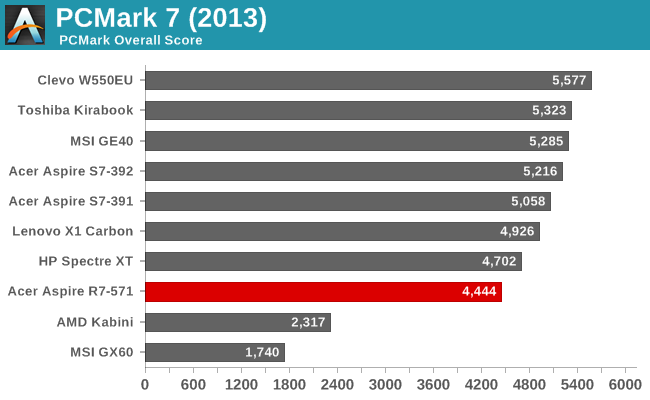
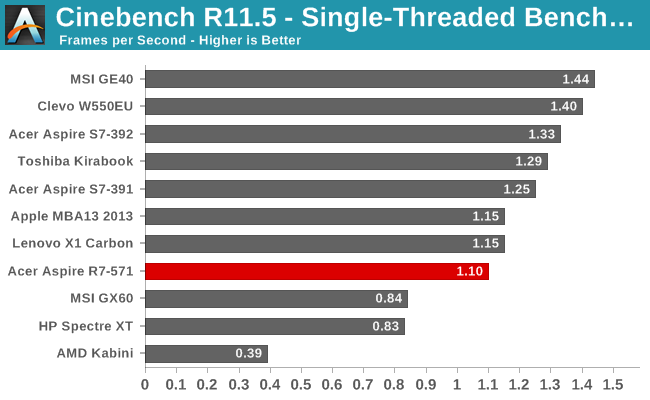
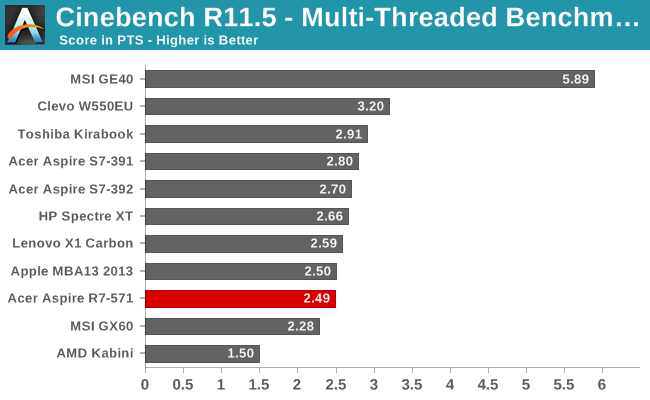
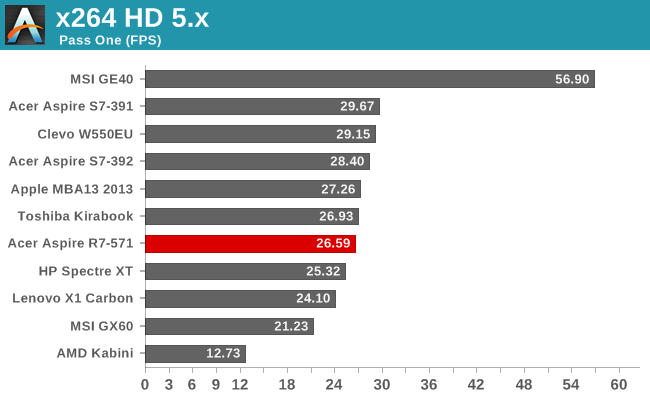
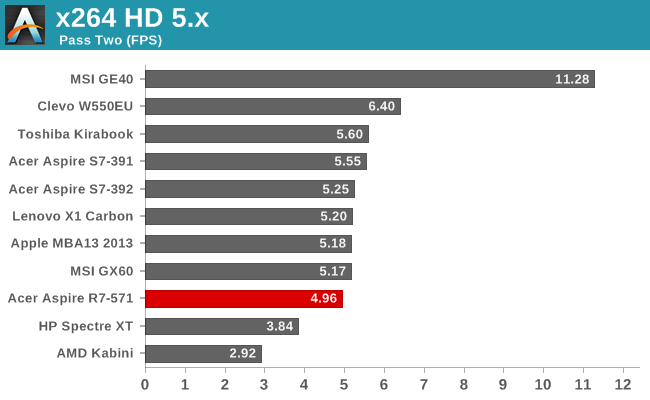
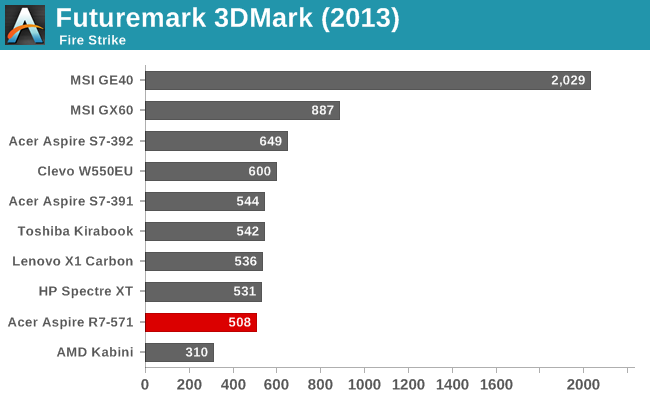


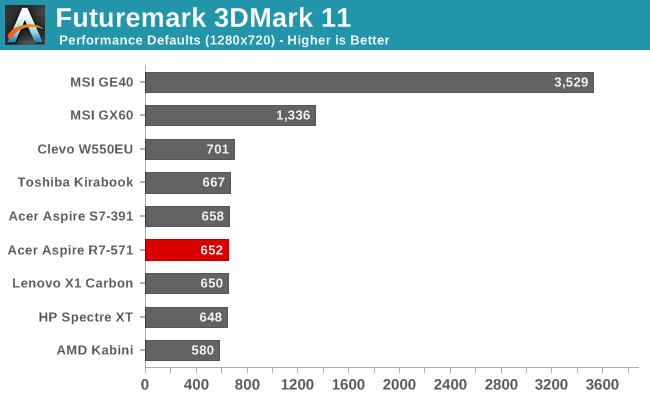
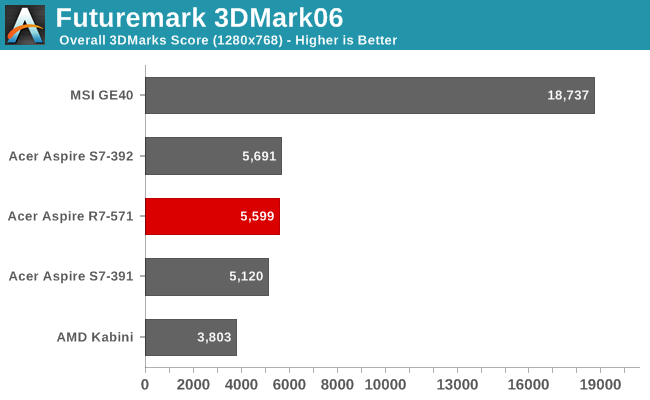

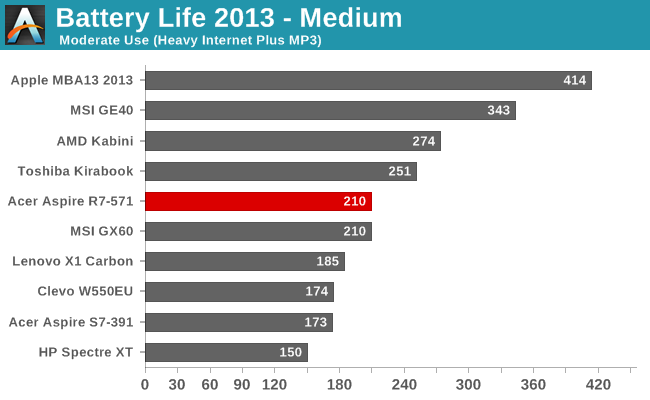
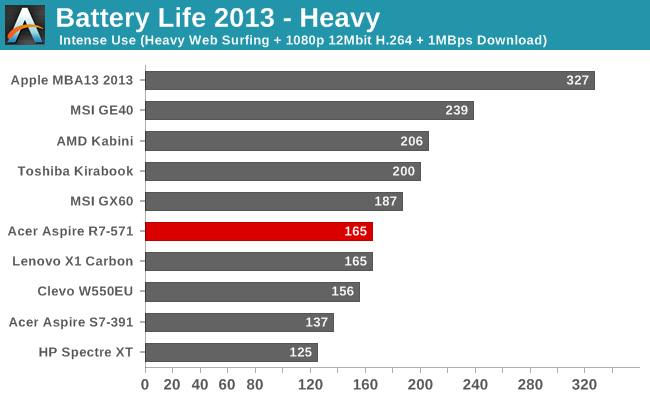
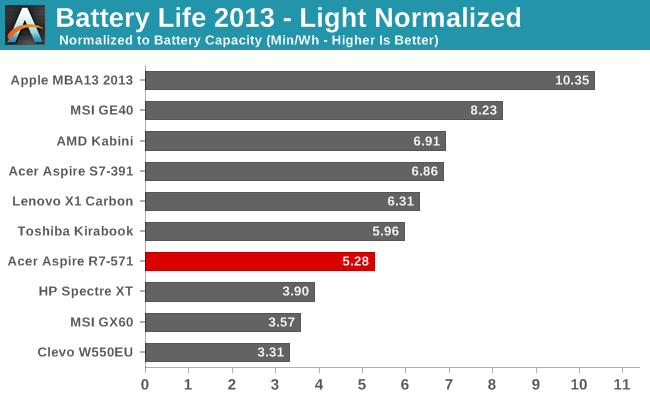
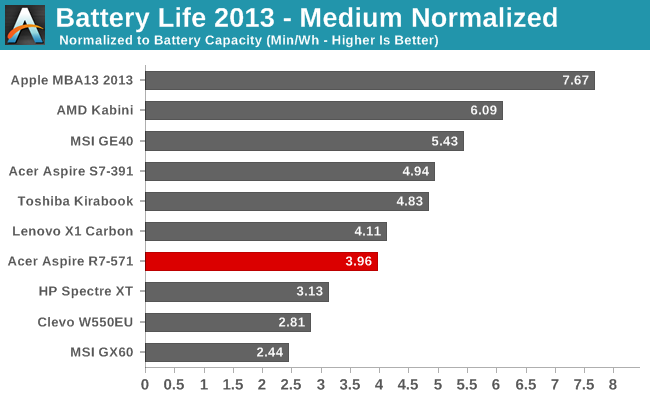
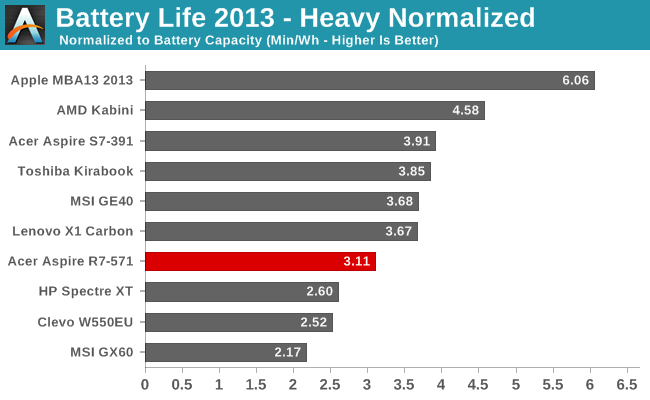
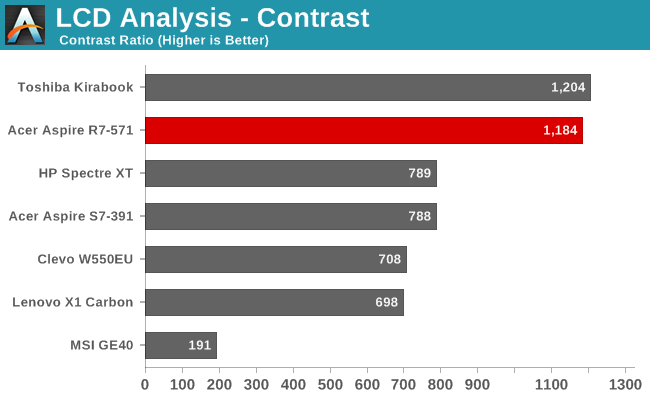

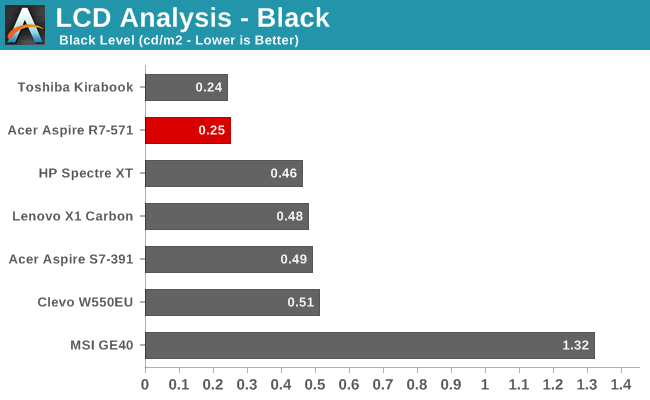
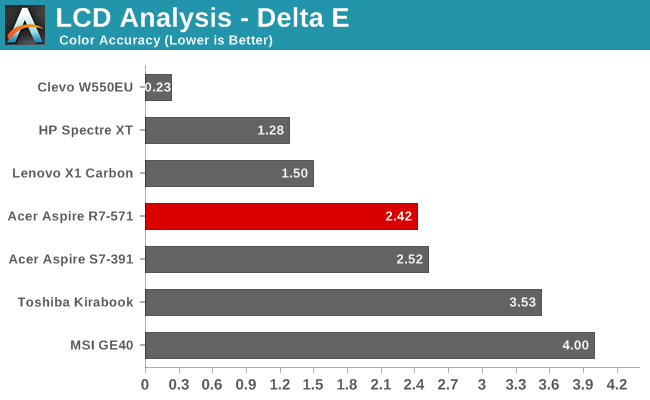
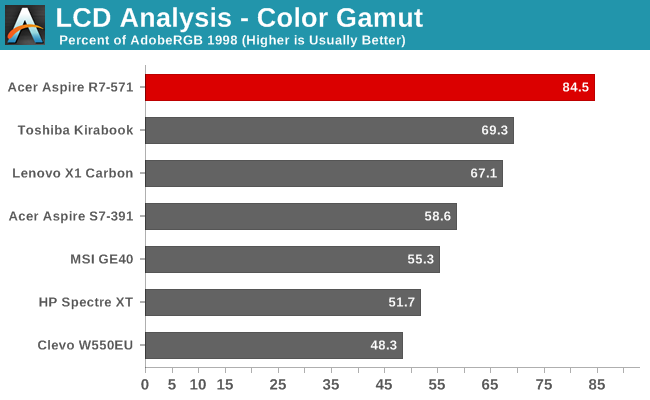
Whew! That’s a lot of benchmarks, and there are even more results in Mobile Bench – like if you really want to know how the R7 handles our gaming suite, for example, it’s there! If you don’t want to look but want a short summary, only one game gets above 10FPS at the Enthusiast settings, and just barely; with Mainstream most of the games fall in the 10-20FPS range, so basically unplayable. Even our Value gaming settings are mostly too much for the HD 4000, though most of the Windows 8 games in the Store are far less demanding and will run just fine – no surprise given most of those are targeting Windows RT, which means GPUs that are often less than half as fast as the HD 4000.
Elsewhere, CPU performance is about where you’d expect it: lower than Core i7 ULV/ULT, and similar to other Core i5 ULV parts. The hybrid storage solution means that PCMark7 doesn’t score quite as well as pure SSDs, but it’s still a huge step up from what you’d get from a pure HDD setup (e.g. GX60). Since I just mentioned the GX60, it’s also interesting to note that Core i5 ULV generally posts better CPU performance than AMD’s Richland APUs – though the second pass of x264 HD at least put AMD slightly ahead. GPU performance is nothing to write home about; it’s more than sufficient for running most Windows tasks, but anything graphically intensive is best off served by a dedicated GPU (or at the very least Intel’s Iris HD Graphics Iris Pro).
Battery life isn’t particularly stellar, but we’ve also seen worse – sometimes much worse. Realistically, four hours of light use is possible off a single charge, while heavier workloads will bring you closer to 2.5 hours. That puts the R7 slightly ahead of the Lenovo X1 Carbon in most tests, but only thanks to its higher battery capacity. In terms of normalized battery life, the R7 places fourth from last of the tested notebooks, and given that Clevo typically doesn’t optimized very well for power use and the MSI GX60 is classified as a gaming notebook, only the win over the HP Spectre XT TouchSmart is really worth mentioning. When we start to look at Haswell-based notebooks, even though Ivy Bridge was pretty good it looks pretty poor in light of what’s now available. Apple’s MacBook Air 13 runs at different OS, but the MSI GE40 has a quad-core Haswell CPU and a slightly larger battery, with about 50% more battery life than the Acer R7.
Wrapping up the benchmarks, as I mentioned before, the one standout item in the R7 is the display. Contrast is excellent, and color quality is at least decent – the 85% color gamut is actually a bit overblown, however, as some of the colors are actually outside of the Adobe RGB 1998 color space while others fall far short (green in particular is lacking). Still, the great viewing angles offered by AHVA combined with good overall performance definitely deserve commendation.










113 Comments
View All Comments
damianrobertjones - Thursday, August 15, 2013 - link
I own a Dell Latitude 10. The MD owns a Surface Pro. The sales guy has a HP Elitpad. The lady in Maastricht has a W510. The factory manager has an Asus Me400c. The Q&A guy has an Acer W500. Shall I go on?They might not be everywhere but statements such as, 'How many people own a Windows 8 tablet?' really do make you sound VERY foolish.
thexile - Thursday, August 15, 2013 - link
You reply is also very foolish as well as. In total, what is overall percentage of the people you know who owns a Windows tablet?andrewaggb - Thursday, August 15, 2013 - link
I know 3 people with windows 8 tablets and 1 person with a surface rt. But I know many more people with ipad's or android tablets (myself included). For me it's the hardware. Even at launch tegra 3 was dated. the current atom is embarrassing, ivy is too power hungry, and amd isn't performance/watt awesome either.I'm assuming with the 8.1 launch we'll see a haswell tablet and hopefully a snapdragon 800 rt device and I guess we can re-evaluate. Real breakthrough might be when the new atom comes out.
andrewaggb - Thursday, August 15, 2013 - link
and to be fair... if Surface rt had launched at $350 with outlook, it would have been an easy sell even with the dated hardware...Mint - Thursday, August 15, 2013 - link
Win8 tablets were always only going to reach their real potential with Silvermont and Haswell. If they're still not selling one year from now, you'll have a point, but as of right now it's rather moot.Looking at Vivek's Air 11 review, even Haswell ULT can sip power better than an iPad4 for equal tasks. I fully expect ULX and ULY to come in hybrid form factors with the tablet part as light as the iPad4 with as good battery life. Silvermont should also cross that "good enough" threshold.
That's when Win8 tablets become a completely non-compromise affair, and take over Android in computing functionality. Win8 was always about the long haul.
kmmatney - Thursday, August 15, 2013 - link
I don't really see them selling that well a year from now, as too many people have already bought iPads or Android tablets. I have an iPad2, and it works fine for email, web browsing, you tube, movies, etc... I'm not against the Surface or a windows tablet (or Android), but my money has already been spent, as well as many other people. And for people buying now, there are decent Android tablets (Nook HD+ or Fire) for much cheaper. I don't think Win8 tablets will reach their full potential until they get the hybrid work/tablet use down pat. It's moving the the right direction, but still not there.lmcd - Thursday, August 15, 2013 - link
It'll be there come Broadwell, no question.JNo - Thursday, August 15, 2013 - link
Maybe but the $99 people spend on a Nook HD for example is more disposable i.e. it acts a stop gap and the real Win 8 tablets with Haswell/Silvermont will easily overtake them functionality wise. At this point the $99 spend on a cheap Android tablet can easily be dismissed and won't stop people upgrading eventually for something that is a superior tablet and can also be used as a full x86 workhorse, despite money invested. The cheaper tablets will always be useful for browsing on the sofa etc so won't be money down the drain.theduckofdeath - Monday, August 19, 2013 - link
Too many people? You know that there are more than tens of millions of people on our planet, right? Tablets could potentially be as dominant as Netbooks were 5 years ago for the low-end computing devices. Though, I don't see iOS achieving that, and I doubt Android will wither, despite the aggressive subsidising campaign from Google and their Nexus devices.theduckofdeath - Monday, August 19, 2013 - link
*either